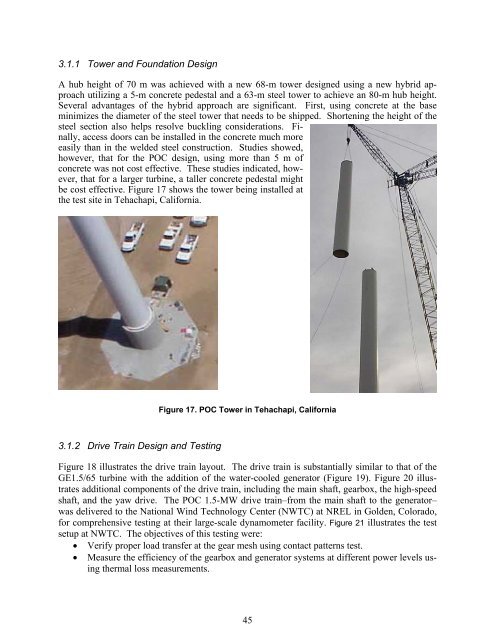Advanced Wind Turbine Program Next Generation Turbine ... - NREL
Advanced Wind Turbine Program Next Generation Turbine ... - NREL
Advanced Wind Turbine Program Next Generation Turbine ... - NREL
Create successful ePaper yourself
Turn your PDF publications into a flip-book with our unique Google optimized e-Paper software.
3.1.1 Tower and Foundation Design<br />
A hub height of 70 m was achieved with a new 68-m tower designed using a new hybrid approach<br />
utilizing a 5-m concrete pedestal and a 63-m steel tower to achieve an 80-m hub height.<br />
Several advantages of the hybrid approach are significant. First, using concrete at the base<br />
minimizes the diameter of the steel tower that needs to be shipped. Shortening the height of the<br />
steel section also helps resolve buckling considerations. Finally,<br />
access doors can be installed in the concrete much more<br />
easily than in the welded steel construction. Studies showed,<br />
however, that for the POC design, using more than 5 m of<br />
concrete was not cost effective. These studies indicated, however,<br />
that for a larger turbine, a taller concrete pedestal might<br />
be cost effective. Figure 17 shows the tower being installed at<br />
the test site in Tehachapi, California.<br />
3.1.2 Drive Train Design and Testing<br />
Figure 17. POC Tower in Tehachapi, California<br />
Figure 18 illustrates the drive train layout. The drive train is substantially similar to that of the<br />
GE1.5/65 turbine with the addition of the water-cooled generator (Figure 19). Figure 20 illustrates<br />
additional components of the drive train, including the main shaft, gearbox, the high-speed<br />
shaft, and the yaw drive. The POC 1.5-MW drive train–from the main shaft to the generator–<br />
was delivered to the National <strong>Wind</strong> Technology Center (NWTC) at <strong>NREL</strong> in Golden, Colorado,<br />
for comprehensive testing at their large-scale dynamometer facility. Figure 21 illustrates the test<br />
setup at NWTC. The objectives of this testing were:<br />
• Verify proper load transfer at the gear mesh using contact patterns test.<br />
• Measure the efficiency of the gearbox and generator systems at different power levels using<br />
thermal loss measurements.<br />
45
















